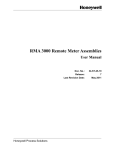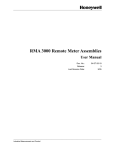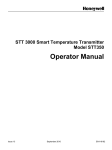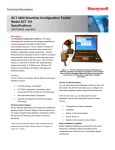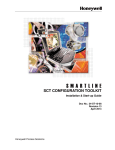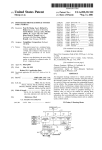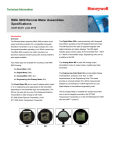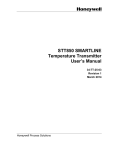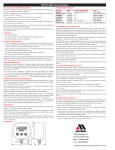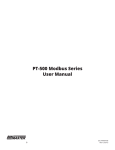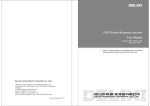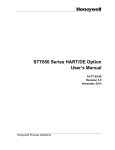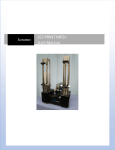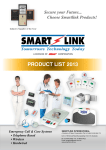Download Honeywell SmartLine EU Meter Users manual, 34-ST-25-18
Transcript
Engineering Unit Meter User Guide Doc. No.: 34-ST-25-18 Revision: 3 Revision Date: 5/08 _________________________________________________________________________________________________________ Honeywell Process Solutions Notices and Trademarks Notices and Trademarks Copyright 2008 by Honeywell International Inc. Revision 3 May, 2008 Honeywell warrants goods of its manufacture as being free of defective materials and faulty workmanship. Contact your local sales office for warranty information. If warranted goods are returned to Honeywell during the period of coverage, Honeywell will repair or replace without charge those items it finds defective. The foregoing is Buyer's sole remedy and is in lieu of all other warranties, expressed or implied, including those of merchantability and fitness for a particular purpose. Specifications may change without notice. The information we supply is believed to be accurate and reliable as of this printing. However, we assume no responsibility for its use. While we provide application assistance personally, through our literature and the Honeywell web site, it is up to the customer to determine the suitability of the product in the application. Honeywell Process Solutions 512 Virginia Drive Fort Washington, PA 19034 Honeywell is a U.S. registered trademark of Honeywell Other brand or product names are trademarks of their respective owners. ii EU Meter User Guide Revision 3 4/08 About This Document About This Document Revision Notes The following list provides notes concerning all revisions of this document. Doc ID Rev ID 34-ST-25-18 Date Notes st Revision 0 9/01 1 Revision 1 7/02 Deleted installation information for Model STT 350 and for remote mounting. Revision 2 6/05 Deleted CE info Revision 3 5/08 Added ATEX Information issue of document. Contacts World Wide Web The following lists Honeywell’s World Wide Web sites that will be of interest to our industrial automation and control customers. Honeywell Organization Corporate WWW Address (URL/e-mail) http://www.honeywell.com Telephone Contact us by telephone at the numbers listed below. Organization United States and Canada Revision 3 4/08 Honeywell Technical Assistance Center EU Meter User Guide Phone Number 1-800-423-9883 Tech. Support 1-800-525-7439 Service iii About This Document Symbol definitions The following table lists those symbols used in this document to denote certain conditions. Symbol Definition This CAUTION symbol on the equipment refers the user to the Product Manual for additional information. This symbol appears next to required information in the manual. This WARNING symbol on the equipment refers the user to the Product Manual for additional information. This symbol appears next to required information in the manual. WARNING: risk of electrical shock. This symbol warns the user of a potential shock hazard where HAZARDOUS LIVE voltages greater than 30 Vrms, 42.4 Vpeak, or 60 VDC may be accessible. ATTENTION, Electrostatic Discharge (ESD) hazards. Observe precautions for handling electrostatic sensitive devices Protective Earth (PE) terminal. Provided for connection of the protective earth (green or green/yellow) supply system conductor. Functional earth terminal. Used for non-safety purposes such as noise immunity improvement. NOTE: This connection shall be bonded to protective earth at the source of supply in accordance with national local electrical code requirements. Earth Ground. Functional earth connection. NOTE: This connection shall be bonded to Protective earth at the source of supply in accordance with national and local electrical code requirements. Chassis Ground. Identifies a connection to the chassis or frame of the equipment shall be bonded to Protective Earth at the source of supply in accordance with national and local electrical code requirements. iv EU Meter User Guide Revision 3 4/08 Contents Contents 1 —EU Meter Description...........................................................................................1 Overview..............................................................................................................................................1 Approvals.............................................................................................................................................1 Function and Design............................................................................................................................1 Meter Description.............................................................................................................................2 Display Features ..............................................................................................................................3 Operating Conditions and Specifications.........................................................................................5 Meter Display at High and Low Temperature Extremes..................................................................5 2 —EU Meter Installation ...........................................................................................6 Overview..............................................................................................................................................6 For more information........................................................................................................................6 Getting Started ....................................................................................................................................6 Tools Required.................................................................................................................................6 Parts Required .................................................................................................................................6 Preparation ......................................................................................................................................6 Integral Mounting with STT 3000 Temperature Transmitters..............................................................7 3 – Setup and Operation ............................................................................................9 Overview..............................................................................................................................................9 Guidelines for setting up the EU meter............................................................................................9 Setup Parameters and Functions........................................................................................................9 Overview of Setup Displays and Operations .................................................................................10 General Procedure for Parameter Access.....................................................................................11 Set Up Lower Range Value and Upper Range Value .......................................................................12 Selecting Engineering Units ..............................................................................................................17 Calibration .........................................................................................................................................19 In-loop Calibration..........................................................................................................................19 Calibrate LO and Calibrate HI........................................................................................................19 Setup Summary.................................................................................................................................20 Operation...........................................................................................................................................22 Self-test Diagnostic ........................................................................................................................22 LCD Check.....................................................................................................................................22 Normal Operating Indications ........................................................................................................23 Revision 3 4/08 EU Meter User Guide v Tables Tables Table 1 Engineering Unit Display Indicator Description ..............................................................................................4 Table 2 EU Meter Specifications...................................................................................................................................5 Table 3 Installing EU Meter in STT 3000 .....................................................................................................................7 Table 4 Example - Setting LRV and URV ..................................................................................................................12 Table 5 Selecting Engineering Units ...........................................................................................................................17 Table 6 Calibrate LO and Calibrate HI........................................................................................................................19 Table 7 Summary of Typical EU meter Indications ....................................................................................................23 Figures Figure 1 Typical Engineering Unit Meter Display ........................................................................................................1 Figure 2 Engineering Unit Display with All Indicators Lit ...........................................................................................2 Figure 3 Wiring Connections for EU Meter to STT 250 ...............................................................................................8 Figure 5 EU Meter Setup Summary ............................................................................................................................21 Figure 6 Self-test Diagnostic and LCD Check ............................................................................................................22 vi EU Meter User Guide Revision 3 4/08 1 —EU Meter Description - Overview 1 —EU Meter Description Overview This manual describes how to install, set up and operate the Engineering Unit Meter display (EU Meter) with a given Honeywell Smartline™ Transmitter or an applicable non-Honeywell transmitter. • It is assumed that you are somewhat familiar with your Honeywell Smartline Transmitter. If you are not familiar with this device, we recommend that you have the instruction manual for your transmitter on hand when you install the EU meter. • If you have installed and used the EU meter before, just skim the data to find the pertinent installation information. • If this is the first time you have installed an EU meter, we recommend that you read this manual before you install the EU meter. Approvals For information concerning ATEX Directive 94/6/EC, Hazardous Location Wiring, and Hazardous Locations Reference, refer to RMA 3000 Remote Meter Assemblies User Manual #34-ST-25-19. Function and Design The Engineering Unit Meter is an LCD indicator that provides a digital display of a transmitter’s output PV when connected in a 4 to 20 mA analog loop. The meter is compatible with Honeywell Smartline Transmitters operating in analog mode and with other non-Honeywell transmitters operating in a 4 to 20 mA current loop. Figure 1 shows a typical meter output display. The display ranges (low range value and high range value) and the engineering units are set locally and are independent of each other. 0 % 5 0. 3 100 % ANALOG Figure 1 Typical Engineering Unit Meter Display Revision 3 4/08 EU Meter User Guide 1 1 —EU Meter Description - Function and Design Meter Description The EU meter is designed to provide a simple indication of a transmitter’s output value. A multisegmented LCD display is encased in a circular black plastic frame for local installation to the transmitter. A printed circuit assembly (PWA) is mounted behind the display and contains the electronics and wire connections for the meter. The EU meter is powered from the transmitter loop current. A momentary contact toggle switch is mounted on the PWA and is used for setting up and verifying the display indication. Figure 2 shows the meter with all its indicators and display segments visible for reference, and Table 1 gives a brief description of each indication. 17-Segment Bargraph (0 to 100%) 0 Digital Readout (-19990 to +19990) % 100 -18 8.80 oF oC % FLOW ANAL OG In H O 2 K GPH mmHg GPM PSI A Engineering Unit Indicators Status Indi cators (Not used on this model) K Multiplier Indicates digital readout is multiplied by 1,000 Figure 2 Engineering Unit Display with All Indicators Lit 2 EU Meter User Guide Revision 3 4/08 1 —EU Meter Description - Function and Design Display Features The display provides a visual indication of transmitter output with the following attributes: • A 17-Segment Horizontal Bargraph gives an indication of the transmitter’s PV output from 0 to 100% that can be read from up to 30 feet away. • A Digital Readout gives a precise indication of transmitter output from -19990 to +19990 in the selected engineering unit. Note that indications in the range of ±199.9 will include a decimal point. Also, readings above 19990 are automatically converted by a 1000 display multiplier (K) so that a value of 20000 would be displayed as 20.0 K. • Status Indicators are part of the display, but appear only in self-diagnostics testing when power is applied. The status indicators are not displayed in normal operation. • Engineering Unit Indicators show what the digital readout represents. These nine units can be selected on the LCD: – – – – °F °C % in H2O – – – – – GPH GPM mmHg PSI PSIA • Additional engineering units can be selected through the use of stick-on labels that are applied to the display area of the meter face. The labels are supplied on a sheet (part number 30756918-001) included with the meter. See Table 1 for a listing of the engineering units available on the label sheet. ATTENTION Please note that the EU meter does not automatically compensate for changes made to setup parameters in either the transmitter or in the EU meter itself. If the Engineering Units selection is changed after setting up range values (LRV and URV), it will be necessary to manually make corresponding changes to the range values. For example, if the meter is set up for °C with lower range values of 0° and 100°, then changing the engineering unit selection to °F will require changing the LRV to 32° and the URV to 212°. Similarly, if the transmitter range were extended from 0 °C –100 °C to 0 °C – 150 °C, the LRV and URV in the EU meter would require corresponding changes. Revision 3 4/08 EU Meter User Guide 3 1 —EU Meter Description - Function and Design Table 1 Engineering Unit Display Indicator Description What It Means When Lit Display Indicator (See Figure 2 for illustration) 17-Segment Bargraph Gives a graphic indication of the transmitter’s PV output from 0 to 100%. Digital Readout Gives an indication of the transmitter’s PV output current. The display range of ±19,990,000 is automatically ranged to provide the best precision possible within the limits of the display. % Digital readout represents output in percent of span. This is the default engineering unit selection. FLOW Status indicator is not used on this model. OUTPUT MODE Status indicator is not used on this model. BAD XMTR STATUS Status indicator is not used on this model. FAULT Status indicator is not used on this model. LAST KNOWN VALUE Status indicator is not used on this model. ANALOG Indicates that the meter is measuring analog current. (Display segment is always on.) K Multiplies digital reading by 1,000. Turns on automatically when reading exceeds 19990. A Indicates an absolute pressure value. Indicator is visible with PSI engineering unit. Engineering Unit Indicators °F °C % inH2O GPH GPM mmHg PSI PSI A blank Additional Engineering Units (stick-on label not shown) These selectable engineering units can be indicated and are available as a stickon label from Honeywell drawing number 30756918-001. 4 Degrees Fahrenheit Degrees Celsius Percent of span Inches of Water Gallons per hour Gallons per minute Millimeters of Mercury Pounds per Square Inch Pounds per Square Inch Absolute no engineering units selected, or custom engineering units. (Use stick-on labels described below.) Kpa Mpa mbar bar g/cm2 Kg/cm2 mmH2O inHg mH2O = = = = = = = = = Kilopascals Megapascals Millibar Bar Grams per Square Centimeter Kilograms per Square Centimeter Millimeters of Water Inches of Mercury Meters of Water EU Meter User Guide Revision 3 4/08 1 —EU Meter Description - Function and Design Operating Conditions and Specifications Before installing a transmitter equipped with a EU meter or installing the EU meter in an existing transmitter, please note the specifications and operating limits of the meter in Table 2. Table 2 EU Meter Specifications Operating Conditions Parameter Ambient Temperature Relative Humidity °F °C %RH Rated Extreme, Transportation and Storage (See below) –40 to 185 –40 to 85 –58 to 194 –50 to 90 10 to 90, non-condensing 0 to 100 Design Characteristics ±0.5% of full range Accuracy Display Resolution Bargraph Digital Readout Minimum Loop Operating Current Maximum Voltage Drop ±3% of reading Shown as: ±0.05 for ±199.9 reading range, ±0.5 for ±1999 reading range, ±5 for ±19990 reading range, ±50 for ±199900 reading range, ±500 for ±1999000 reading range, ±5000 for ±19990000 reading range. 199.9 1999 19.90 K 199.9 K 1999 K 19990 K 3.6 mA 2.3 V Meter Display at High and Low Temperature Extremes The rated temperature limits for the meter are listed above and are correct in that no damage to the meter will occur over these temperatures. However, the readability of the LCD is affected if taken to these temperature extremes: • At higher temperatures, the LCD will turn black at temperatures between 80 to 90 °C (176 and 194 °F), rendering the display unreadable. This effect is only temporary, and normally occurs at 90 °C (194 °F). • At low temperatures, the update rate of the display is lengthened to 1.5 seconds due to the slower response time of the display. At -20° C (-4 °F) the display becomes unreadable due to slow response of the LCD. This is also only temporary and normal readability will return when temperature rises above -20 °C (-4 °F). Revision 3 4/08 EU Meter User Guide 5 2 —EU Meter Installation - Overview 2 —EU Meter Installation Overview This section covers the physical installation of the EU meter integrally and remotely with compatible Honeywell field devices, as well as remote installation with other non-Honeywell transmitters. The EU meter is compatible with the following Honeywell Smartline Transmitters operating in analog mode: • STT 3000 Smart Temperature Transmitters (STT350 and STT250 - models 25M, 25D in analog mode, 25H* and 25T) * Meter is compatible with STT25H operating in point to point loop. For more information Refer to RMA 3000 Remote Meter Assemblies User Manual (Honeywell document number 34-ST-25-19) for details on installation, wiring, etc. Getting Started Tools Required Screwdriver (medium blade) Parts Required If either the display is to be installed integrally with the transmitter, or if the transmitter is installed within an explosion-proof enclosure equipped with a meter cover, ensure that the transmitter has a “windowed” meter cap. (A meter end cap and meter cover used with the meter provides space for the meter, and has a glass window to allow for the installation and viewing of the display.) Preparation • Remove power from the transmitter • Remove the meter end cap or meter cover 6 EU Meter User Guide Revision 3 4/08 2 —EU Meter Installation - Integral Mounting with STT 3000 Temperature Transmitters Integral Mounting with STT 3000 Temperature Transmitters The EU meter can be installed integrally with Honeywell STT 3000 Temperature Transmitters. The procedure in Table 3 shows you how to install the EU meter with any of three STT 3000 transmitters mounted in an explosion-proof housing. Refer to Figure 3 for wiring connections to the Model 250 transmitter. ATTENTION If the meter is already installed with the transmitter, remove it by releasing the meter’s mounting legs and pulling the meter toward you, so that you can connect field wiring and can check the connections of the meter to the transmitter. Table 3 Installing EU Meter in STT 3000 Step 1 2 Action Remove cover to transmitter housing. Refer to: • Figure 3 if installing the meter to the Model 250 transmitter 3 Revision 3 4/08 Connect Yellow lead from EU meter to Signal – terminal on transmitter. 4 For the STT 250 transmitter, connect a lead from the positive (+) node of the receiver (typically a 250-ohm resistor) to the terminal screw inside the transmitter housing as shown in Figure 3. 5 Connect the Blue lead from the EU meter to the same terminal as specified in Step 4 above. 6 Connect a lead from the positive (+) node of the power supply to the Signal positive (+) terminal on the transmitter. 7 Consult the transmitter's instruction manual(s) to make other field wiring connections. 8 Rotate or orient the EU meter for proper viewing through the cover window, align feet on the meter with the holes in the spacer assembly, and press the meter into place. 9 Go to Section 3 to set up the EU meter. 10 Replace the transmitter housing cover. EU Meter User Guide 7 2 —EU Meter Installation - Integral Mounting with STT 3000 Temperature Transmitters STT 250 Smart Temperature Transmitter in explosionproof housing FS U 4 1 Ω _ 250 D 3 2 Receiver + + Power Supply - Yellow Blue 0 % 100 Figure 3 Wiring Connections for EU Meter to STT 250 8 EU Meter User Guide Revision 3 4/08 3 – Setup and Operation - Overview 3 – Setup and Operation Overview This section covers the procedures for setting up the EU meter display for use in your process application. To set up the meter for operation with a given transmitter, you must: - set the 4 mA and 20mA values for the meter display, and - select an appropriate engineering unit. Guidelines for setting up the EU meter Follow these guidelines when setting up the EU meter: • Operating the Setup Switch, which is located at the bottom of the EU meter frame, provides access to all setup parameters and their values. (See figure on next page for location of the switch). This switch is a three-position momentary switch that can be operated to the left and to the right of center position. The switch is spring-loaded, so that it returns it to center position when it is released. • Typically, when the meter is in the setup mode, the display is limited to only the active setup field (either a parameter name or a parameter value), as indicated under Overview of Meter Displays and Operations, following. Condensed procedures and references to tables of detailed setup procedures are given under the heading General Procedure for Parameter Access. A summary of the EU meter setup procedure is given in Figure 5. • After making any adjustments to the meter, exit the setup mode to ensure that the new meter settings are saved (written to non-volatile memory). Before you begin, be sure that the EU meter has been installed and wired properly. ATTENTION EU meter default values for low range and high range are 0 and 100. The default engineering unit is percent (%). Setup Parameters and Functions The following parameters are available and can be set up or changed on the EU meter display: • Low Range Value (LO) – Lower Range Value (LRV); number that represents 4 mA (0%) output. • High Range Value (HI) – Upper Range Value (URV); a number that represents 20 mA (100%) output. • Engineering Unit (EU) – Selection of a value appropriate for your application. • Calibrate Low (Clo) – Calibrate the meter to a 0% output indication. • Calibrate High (Chi) – Calibrate the meter to a 100% output indication. • Lcd – This function provides a means of checking all segments and fields of the display. • End – This function Exits setup parameter selections. Revision 3 4/08 EU Meter User Guide 9 3 – Setup and Operation - Setup Parameters and Functions Overview of Setup Displays and Operations 1. In the Monitor Mode, operate the Setup Switch to the Left to enter the configuration mode. Then, operate the switch repeatedly to the left until the desired parameter (e.g., HI) appears. Monitor Mode Configuration Mode 0 When “End” appears in the display, you can operate the switch to the right to return to the monitor mode. OUTP UT MODE BAD TR STATUS XM FAUL T - L AST KNOWN VALUE Operate switc h to RIGHT t o configure parameters or t o Exit to Monitor Mode when End is displayed. 2. With the desired parameter selected: - operate the Setup Switch to the right repeatedly until the desired display position (1-8 in the picture at right) is selected. – operate the Setup Switch to the left repeatedly until the desired number appears, or until the desired symbol appears or disappears. The numbers or symbols that can be set for each display position appears in the table at the bottom of the picture at right. 10 100 % -18 8. 8 0 1 2 3 HI Chi Lcd 5 EU EU Meter User Guide In H O 2 G PH mm Hg GP PSIA M Clo End 6 7 8 First, operate setupswitch to right to select display position 1-8. K % F LOW Operate s witch to LEFT to enter Configuration Mode and t o sequenc e through parameters. LO 4 ANAL OG oF oC Then, in Display Operate Setup switch Position to LEFT to sel ect: 1 2 3 4 5 6 7 8 number (1) or blank number (0-9) or blank number (0-9) or blank decimal point (.) or blank number (0-9) or blank number (0) or blank symbol K (x1000) or blank symbol minus (-) or blank Revision 3 4/08 3 – Setup and Operation - Setup Parameters and Functions General Procedure for Parameter Access Apply power to transmitter and wait for EU meter to run its self-diagnostic tests. Self-test Diagnostic Example – EU meter self-test display. 0 % 100 -18 8. 8 0 oF oC % FLOW OUTPUT MODE ANALOG In H O 2 BAD XMTR STATUS GPH mmHg FAULT - LAST GPM PSI A KNOWN VALUE K Operate setup switch on bottom side of the meter to the left once. The display reads LO (Lower Range Value). Select Setup Parameter 0 % 100 L0 Setup Switch To step through the parameters until the desired parameter is visible on the display, repeatedly operate the Setup Switch to the left. Go to the following tables for the setup procedure of that parameter: LO – Lower Range Value (LRV; See Table 4. HI – High Range Value (Upper Range Value, or URV; See Table 4. EU – Engineering Unit, See Table 5. Clo – Calibrate LO, See Table 6. Chi – Calibrate HI, See Table 6. See Figure 4 for a summary of the EU meter setup procedure. Revision 3 4/08 EU Meter User Guide 11 3 – Setup and Operation - Set Up Lower Range Value and Upper Range Value Set Up Lower Range Value and Upper Range Value Setting the Lower Range Value (LRV) and the Upper Range Value (URV) of the meter display defines the analog (4 mA to 20 mA) range of transmitter output values that are displayed. (The meter does not read the DE message of Honeywell smart transmitters). The example procedure in the Table 4 sets the display range value for 180.00. Set low and high range values according to your application. ATTENTION Please note that the EU meter does not automatically compensate for changes made to setup parameters in either the transmitter or in the EU meter itself. If the Engineering Units selection is changed after setting up range values (LRV and URV), it will be necessary to manually make corresponding changes to the range values. For example, if the meter is set up for °C with lower range values of 0° and 100°, then changing the engineering unit selection to °F in either the EU meter or in the transmitter will require changing the LRV to 32° and the URV to 212° in the meter. Table 4 Example - Setting LRV and URV Step Action EU Meter Next 1 Apply power to transmitter and wait for EU meter to run its selfdiagnostic tests. Self-test Diagnostic Example – EU meter self-test display. (Note: During diagnostic testing, status indicators will appear at the lower-left of the display for about 2 seconds, and will then disappear.) 2 0 % 100 -18 8. 8 0 oF oC % FLOW OUTPUT MODE ANALOG In H O 2 BAD XMTR STATUS GPH mmHg FAULT - LAST GPM PSI A KNOWN VALUE K Operate the setup switch on bottom side of the meter to the left one time. To view the current low range value, operate the Setup Switch to the right one time. Select LO The meter displays “LO” (the LRV parameter). 0 % L0 100 ATTENTION If the range value on the display is correct, move the switch to the left and proceed to the next setting for the display. See Step 12 for setting High Range Value. Procedure continued on next page ⇒ 12 EU Meter User Guide Revision 3 4/08 3 – Setup and Operation - Set Up Lower Range Value and Upper Range Value Step Action EU Meter Next 3 To change or select the Lower Range Value, operate the setup switch to the right. A “1” is visible on the display. (The leading “1” on the digital readout.) Set Leading "1" When the desired value is visible, operate the Setup Switch to the right to select the next digit. Operating the switch to the left repeatedly will toggle the value between “1” or a blank. 0 100 % 1 Move switch left to select either "1" or blank. 4 A zero (“0”) appears to the right of the digit just configured. When the desired value is visible, operate the switch to the right to select the next digit. Set First Digit To set the numerical value of this digit, repeatedly operate the switch to the left. 0 % 100 18 0 1 2 3 4 5 6 7 8 9 blank Move switch left to step through values. 5 A zero (“0”) appears. Set Second Digit To set the numerical value of this digit, repeatedly operate the switch to the left. 0 % 100 180 0 1 2 3 4 5 6 7 8 9 blank When the desired value is visible, operate the switch to the right to select the next indicator. Move switch left to step through values. Procedure continued on next page ⇒ Revision 3 4/08 EU Meter User Guide 13 3 – Setup and Operation - Set Up Lower Range Value and Upper Range Value Step 6 Action A decimal point (“.”) appears. Operating the switch to the left toggles between “.” and blank. EU Meter Next Set Decimal Point When the desired indication is visible, operate the switch to the right to select the next digit. 0 100 % 180. Move switch left to select either . (decimal point) or blank. 7 Set Third Digit A zero (“0”) appears. To set the numerical value of this digit, repeatedly operate the switch to the left. 0 0 1 2 3 4 5 6 7 8 9 blank 100 % 180.0 When the desired value is visible, operate the switch to the right to select the next value. Move switch left to step through values. 8 A zero (“0”) appears. Set Trailing "0" When the desired value is visible, operate the switch to the right to select the next indicator. (The “0” is the trailing zero of the digital readout.) Operating the switch to the left repeatedly will toggle the value between “0” or a blank. 0 % 100 180.00 Move switch left to select either "0" or blank. Procedure continued on next page ⇒ 14 EU Meter User Guide Revision 3 4/08 3 – Setup and Operation - Set Up Lower Range Value and Upper Range Value Step 9 Action A “K” appears at the bottom of the display. When the “K” is visible, it indicates that the numerical value on the display should be multiplied by 1000. 0 EU Meter Next Set Multiplier When the desired value is visible, move switch to the right to select the next indicator. 100 % 180.00 (For example, in the display at right, the meter indicates a value of 180.00 x 1000, or 180,000.00.) K Operating the switch to the left toggles between “K” and blank. Move switch left to select either "K" or blank. 10 Set Sign A minus sign (“-”) is visible. When the desired value is visible, move switch to the right to enter the value. (Use the minus sign if you want to indicate negative values on the display.) Operating the switch to the left toggles between “-” and blank. 0 % 100 -180.00 Move switch left to select either "-" or blank. 11 The word YES is visible for one second indicating that the range value has been set successfully. The display returns to the setup parameter that was selected. 0 % 100 YES Procedure continued on next page ⇒ Revision 3 4/08 EU Meter User Guide 15 3 – Setup and Operation - Set Up Lower Range Value and Upper Range Value Step 12 Action Operate the switch to the left to indicate the next setup parameter. EU Meter Next Select Hi To view the current high range value, operate the setup switch to the right one time. The meter displays “HI” (the URV parameter). 0 % 100 HI 13 Follow steps 3 through 11 to set the high range value for the display. 0 % YES 14 16 Operate the switch to the left to show the next setup parameter. 100 ATTENTION If the range value on the display is correct, operate the switch to the left, and proceed to the next setting for the display. The word YES is visible for one second, indicating that the range value has been set successfully. The display returns to the setup parameter that was selected. See Table 5 to set the Engineering Units value for the EU meter. EU Meter User Guide Revision 3 4/08 3 – Setup and Operation - Selecting Engineering Units Selecting Engineering Units Use the procedure in Table 8 to select the desired engineering unit for display. ATTENTION Please note that the EU meter does not automatically compensate for changes made to setup parameters in either the transmitter or in the EU meter itself. If the Engineering Units selection is changed after setting up range values (LRV and URV), it will be necessary to manually make corresponding changes to the range values. For example, if the meter is set up for °C with lower range values of 0° and 100°, then changing the engineering unit selection to °F in either the EU meter or in the transmitter will require changing the LRV to 32° and the URV to 212° in the meter. Table 5 Selecting Engineering Units Step Action EU Meter Next 1 Apply power to transmitter (if not powered) and wait for EU meter to run its self-diagnostic tests. Self-test Diagnostic Example – EU meter self-test display. 0 % 100 -18 8. 8 0 oF oC % FLOW OUTPUT MODE ANALOG In H O 2 BAD XMTR STATUS GPH mmHg FAULT - LAST GPM PSI A KNOWN VALUE K 2 Move switch to the left and release to step through setup parameters until the display reads EU. To see the current engineering unit selection, move setup switch to the right once. Select EU 0 % EU 100 ATTENTION If the EU value on the display is correct, move the switch to the left and proceed to the next setting for the display. Procedure continued on next page ⇒ Revision 3 4/08 EU Meter User Guide 17 3 – Setup and Operation - Selecting Engineering Units Step Action 3 To sequence through the engineering units values, repeatedly operate the switch to the right. EU Meter Next Set Engineering Unit 0 When the desired EU value is visible, operate the switch to the left. % inH2O mmHG PSI PSIA C F GPH GPM blank 100 % % EU in Percent is default. NOTE: Select “blank” when using engineering units that are not on the display. Use stick-on labels from Honeywell drawing number 30756918-001. Move switch right to step through EU values. 4 The word YES is visible for one second, indicating that the EU value has been set successfully. The display returns to the setup parameter that was selected (EU, in this case). 0 % 100 YES 5 18 Operate the switch to the left to select the next setup parameter. EU Meter User Guide Revision 3 4/08 3 – Setup and Operation - Calibration Calibration The EU meter is calibrated at the factory before shipment, but you may want to calibrate the meter to the transmitter output after installation and setup. The display is calibrated at 0% and 100% PV values. In-loop Calibration You can calibrate the EU meter in the loop by putting the Honeywell Smartline transmitter into its OUTPUT mode so that it can be used as a current source. Be sure to put the loop into MANUAL mode first; then, set the transmitter's output to 0 % (4 mA) for the meter's "zero" calibration, (Clo), and 100 % (20 mA) for its span calibration, (Chi). When the meter is used with a Honeywell Smart line Transmitter, this is the preferred calibration method. Otherwise, you must obtain an accurate current source to calibrate the EU meter separately. Calibrate LO and Calibrate HI Follow the steps in Table 6 to calibrate the meter. Table 6 Calibrate LO and Calibrate HI Step Action EU Meter Next 1 Apply power to transmitter (if not powered), and wait for EU meter to run its self-diagnostic tests. Self-test Diagnostic Example – EU meter self-test display. 0 % 100 -18 8. 8 0 oF oC % FLOW OUTPUT MODE ANALOG In H O 2 BAD XMTR STATUS GPH mmHg FAULT - LAST GPM PSI A KNOWN VALUE K 2 Operate the setup switch to the left repeatedly to step through setup parameters until the display reads “Clo” (Calibrate Low.) Select Calibrate LO 0 % 100 Clo Procedure continued on next page ⇒ Revision 3 4/08 EU Meter User Guide 19 3 – Setup and Operation - Setup Summary Step 3 Action EU Meter Next % The word YES is visible for one second, indicating that the 0% calibration has been set successfully. Provide an input to the transmitter so that the output is 4.0 mA (0% PV). Operate the switch to the right. 0 100 YES 4 Operate the switch to the left until the display reads “Chi” (Calibrate High). NOTE: If the output value is not between 3.4 and 4.8 mA, the display will indicate “Err”. Adjust 0% output and repeat step 3. Select Calibrate HI 0 % 100 ChI 5 Provide an input to the transmitter so that the output is 20 mA (100% PV). Move switch to the right. 0 % 100 YES The word YES is visible for one second, indicating that the 100% calibration has been set successfully. NOTE: If the output value is not between 18.6 and 21.6 mA, the display will indicate “Err”. Adjust 100% output and repeat step 5. Setup Summary Figure 4 provides a summary of the setup procedures for the EU meter. 20 EU Meter User Guide Revision 3 4/08 Revision 3 4/08 EU Meter User Guide End L next Lcd L next Chi L next Clo L next EU L next HI L next LO L list 87.4% L again R done current value yes or Err yes or Err L done units, blank 1, blank 1, blank 0 - 9, blank L done yes or Err 0 - 9, blank L change next R L change next R L done all toggle segments R off 0 - 9, blank 0 - 9, blank L change L change next R next R Check Display Segments Calibrate at 20.0 mA Calibrate at 4.0 mA Set Engineering Units R change edit R L change edit R L change edit R Err or OL all segments on L done current value L done calibrate R view R current value L done calibrate R view R view R view R hardware failure or display overlimit dec pt, blank dec pt, blank 0 - 9, blank 0 - 9, blank L change L change next R next R Set High Range Value L change next R L change next R Set Low Range Value 0, blank 0, blank L change next R L change next R R L K, blank K, blank L change next R L change next R minus, blank minus, blank done R done R yes or Err yes or Err Move Switch Right Move Switch Left Indicates hardware failure or value out of range Flashing Display Indicates success (yes) or failure (Err) Momentary Display Normal Display LEGEND L change next R L change next R 3 – Setup and Operation - Setup Summary Figure 4 EU Meter Setup Summary 21 3 – Setup and Operation - Operation Operation Once the EU meter has been set up (the LRV, URV and engineering units have been selected and calibration has been completed), you can begin monitoring meter indications for transmitter PV output. The self-test indications and some typical operating indications are outlined in this section for reference. Self-test Diagnostic Every time power is cycled to the transmitter and during normal operation, the EU meter runs a self-test to check several internal operations. When power is first applied to the transmitter, the meter shows all display segments for about 2 seconds so they can be visually checked for uniform appearance. If the selftest fails, the display will show “Err”. 0 % 100 -18 8.80 oF oC % FLOW ANALOG OUTPUT MODE BAD XMTR STATUS FAULT - LAST KNOWN VALUE In H O 2 K GPH mmHg GPM PSI A Status Indicators are visible during self-test and LCD check, but are not used in normal operation. Figure 5 Self-test Diagnostic and LCD Check LCD Check The LCD selection in the setup parameters also provides a check of all display segments and fields. To access the LCD selection: 22 1. Operate the setup switch left to step through the setup parameters until the display indicates LCD. 2. Operate the switch to the right to show all display segments. 3. Operate the switch to the right once more to blank out all display segments. 4. To exit the LCD check, operate the switch to the left until the display reads End. 5. Operate the switch to the right. The display returns to normal operating indications. EU Meter User Guide Revision 3 4/08 3 – Setup and Operation - Operation Normal Operating Indications The EU meter continuously shows output values and selected engineering units during normal operation. Table 7 shows a number of typical meter indications. Note that other combinations of the display are possible. Table 7 Summary of Typical EU meter Indications Meter Indication 0 What It Means % 0 Meter Indication What It Means No power applied. Display is blank. Meter has detected an internal hardware fault, or the meter current is out of range for either 0% or 100% calibration. See Table 6, in Calibration section. Normal display for meter. Display flashes. Transmitter output has exceeded the meter’s display range. 100 % 100 2 5.3 Digital readout indicates pressure of 25.3 inches of water. 0 % OL ANALOG 100 oC ANALOG in H O 2 Normal display for meter. 0 % 100 99 9 0 Digital readout indicates 9,990,000 gallons per hour. 0 % 10 6.9 ANALOG K 100 % ANALOG GPH Normal display for meter. 0 % 5 0. 3 ANALOG Revision 3 4/08 Display flashes. Meter current has exceeded 20.4 mA, or 102.4% of span. 100 % Digital readout indicates transmitter output of 50.3 %. % (Percent) is The meter’s default engineering unit. 0 % End EU Meter User Guide 100 Meter is in setup mode. Operate the setup switch to the right to exit setup and return to normal operating display. See Setup Parameters on Page 9 for more information. 23 3 – Setup and Operation - Operation Revision 3 4/08 EU Meter User Guide 25 - Honeywell Process Solutions 512 Virginia Drive Fort Washington, PA 19034
































